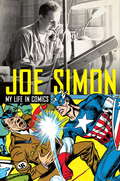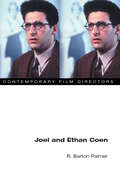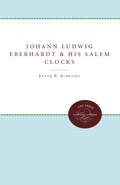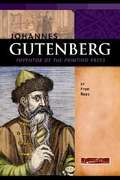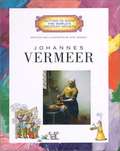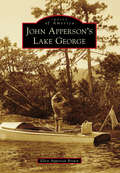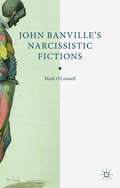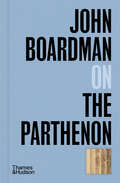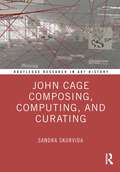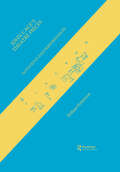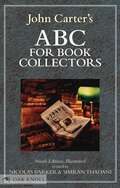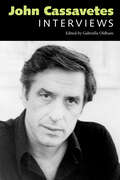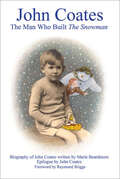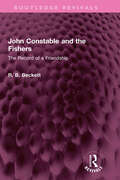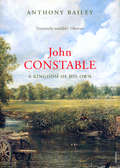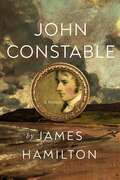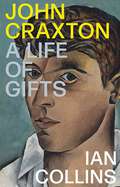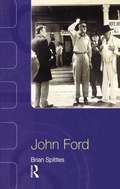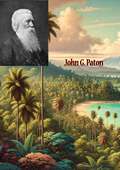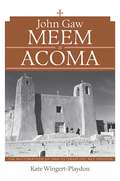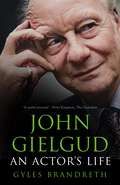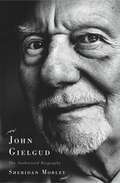- Table View
- List View
Joe Simon: My Life in Comics
by Joe SimonIn his own words, this is the life of Joe Simon, one of the most important figures in comics history, and half of the famous creative team Simon and Kirby. Joe Simon co-created Captain America, and was the first editor in chief of Marvel Comics (where he hired Stan Lee for his first job in comics). Simon began his prolific career in the Great Depression, and this book recounts his journey to New York City, his first comic book work, his meeting with Jack Kirby, and the role comics played in wartime America. He remembers the near-death of the comics, and the scramble to survive. And he reveals what it was like to bring comics out of their infancy, as they became an American art form.
Joel and Ethan Coen (Contemporary Film Directors)
by R. Barton PalmerWith landmark films such as Fargo, O Brother Where art Thou?, Blood Simple, and Raising Arizona, the Coen brothers have achieved both critical and commercial success. Proving the existence of a viable market for "small" films that are also intellectually rewarding, their work has exploded generic conventions amid rich webs of transtextual references. R. Barton Palmer argues that the Coen oeuvre forms a central element in what might be called postmodernist filmmaking. Mixing high and low cultural sources and blurring genres like noir and comedy, the use of pastiche and anti-realist elements in films such as The Hudsucker Proxy and Barton Fink clearly fit the postmodernist paradigm. Palmer argues that for a full understanding of the Coen brothers' unique position within film culture, it is important to see how they have developed a new type of text within general postmodernist practice that Palmer terms commercial/independent. Analyzing their substantial body of work from this "generic" framework is the central focus of this book.
Johann Gutenberg: the Inventor of Printing
by Victor ScholdererThis short book draws on legal documents surviving from the 15th century, in an attempt to piece together information about the life of the inventor of the printing press. When all is said and done, however, very little can actually be known about Gutenberg's life.
Johann Ludwig Eberhardt and His Salem Clocks (Old Salem Series)
by Frank P. AlbrightEberhardt (1758-1839) was master clockmaker in Salem for more than thirty-eight years. Albright attributes more than thirty clocks to Eberhardt, building his evidence by a diligent reading of the Moravian records and by a careful cataloging of the characteristics of each clock. He reconstructs Eberhardt's methods of clockmaking in precise detail from the inventories and the purchase invoices of equipment and materials, and he attempts to identify the cabinetmaker in each case.Originally published in 1978.A UNC Press Enduring Edition -- UNC Press Enduring Editions use the latest in digital technology to make available again books from our distinguished backlist that were previously out of print. These editions are published unaltered from the original, and are presented in affordable paperback formats, bringing readers both historical and cultural value.
Johannes Gutenberg: Inventor Of The Printing Press (Signature Lives Series)
by Fran Rees Frank Romano Rosemary G. PalmerA biography profiling the life of Johannes Gutenberg, a man from the Renaissance era who is best known for developing the printing press that took the place of the time-consuming method of copying books by hand. <P><P>Gutenberg's greatest accomplishment was the printing of a Latin Bible -- the Gutenberg Bible, as it came to be known. His name became forever linked to this magnificent masterpiece and to the printing press that transformed the world.
Johannes Vermeer: Getting to Know the World's Greatest Artists
by Mike VeneziaA biography of Johannes Vermeer. An overview of the life and work of the seventeenth-century Dutch painter, famous for creating realistic scenes of everyday life.
John Apperson's Lake George (Images of America)
by Ellen Apperson BrownIn 1900, John Apperson, a young man from Virginia, began working for General Electric in Schenectady, New York. An avid hiker and outdoor enthusiast, Apperson soon found others interested in Adirondack sports such as ice-fishing and skate-sailing, and they started taking camping trips into the north country. He discovered Lake George one summer while attending a boat race, and thus began his lifelong love affair with the magnificent scenery. Apperson devoted his energy and resources to saving the land from various threats, including commercial development, logging, illegal squatters, and erosion. Apperson launched a two-pronged strategy, promoting Lake George for its recreational potential while recruiting people to help repair the shores of islands. He earned the respect of leading politicians, philanthropists, and journalists, including George Foster Peabody, New York governor Al Smith, and Franklin and Eleanor Roosevelt. His actions brought him into open conflict with powerful adversaries, too.
John Banville’s Narcissistic Fictions: The Spectral Self
by Mark O’ConnellIn reading Banville's novels through the work of key psychoanalytical theorists, John Banville's Narcissistic Fictions brings together apparently disparate thematic strands - missing twins, shame, false identities - and presents these as manifestations of a central concern with narcissism.
John Boardman on the Parthenon (Pocket Perspectives #2)
by John BoardmanBritain's most distinguished historian of ancient Greek art recounts what the Parthenon and its sculptures meant to the citizens of fifth-century BCE Athens. Surprising, questioning, challenging, enriching: the Pocket Perspectives series presents timeless works by writers and thinkers who have shaped the conversation across the arts, visual culture, and history. Celebrating the undiminished vitality of their ideas today, these covetable and collectable little books embody the best of Thames & Hudson.
John Cage Composing, Computing, and Curating (Routledge Research in Art History)
by Sandra SkurvidaThis study reassesses Cage’s multifaceted practice from a transdisciplinary perspective, using text as a premise for his musical, visual, lingual, and museal compositions.In his compositions, John Cage opened the structures of music, language, and the museum to change perpetuated by chance operations. His correspondences across history with an extended circle of creators, including Erik Satie, Marcel Duchamp, and Henry David Thoreau, among many others, erased single-minded authorship via methodical processing of source material. Foreshadowing ecological recycling, Cage’s late compositions for museum opened perspectives for posthuman mediation in curating and contemporary art. He conceived of anarchy as the coexistence of mutually aiding yet autonomous self-determinate entities. This book introduces Cage to the twenty-first century as a composer whose work intersects different temporalities and modes of being, the past and the present, the human and the non-human, and the individual and the communal.The book will be of interest to scholars of art history, music, curatorial studies, and museum studies.
John Cage's Theatre Pieces (Contemporary Music Studies #Vol. 11.)
by William FettermanThe experimental composer John Cage (1912-1992) is best known for his works in percussion, prepared piano, and electronic music, but he is also acknowledged to be one of the most significant figures in 20th century theatre. In Cage's work in theatre composition there is a blurring of the distinctions between music, dance, literature, art and everyday life. Here, William Fetterman examines the majority of those compositions by Cage which are audial as well as visual in content, beginning with his first work in this genre in 1952, and continuing through 1992.Much of the information in this study comes from previously undocumented material discovered among the unpublished scores and notes of Cage and his frequent collaborator David Tudor, as well as author's interviews with Cage and with individuals closely associated with his work, including David Tudor, Merce Cunningham, Bonnie Bird, Mary Caroline Richards, and Ellsworth Snyder.
John Carter's ABC for Book Collectors
by John Carter Nicolas Barker Simran ThadaniThis ninth edition has been thoroughly revised and re-edited by Nicolas Barker, former Editor of The Book Collector, and Simran Thadani, Executive Director of Letterform Archive. With a new Introduction, it incorporates new terms, additions and amendments and, for the first time, illustrations in black & white and color. Nicolas Barker worked with his friend John Carter revising the ABC up to the latter's death in 1975 and has faithfully preserved the spirit of the original. ABC for Book Collectors, while keeping us up-to-date with modern terminology, retains its humorous character and importance as the one indispensable guide to book collecting.
John Cassavetes: Interviews (Conversations with Filmmakers Series)
by Gabriella OldhamAmerican filmmaker John Cassavetes (1929-1989) made only nine independent films during a quarter century, but those films affected the cinema culture of the 1960s to the 1980s in unprecedented ways. With a close nucleus of actors and crew members on his team, including his wife Gena Rowlands, Peter Falk, and Ben Gazzara, Cassavetes created films that explored the gritty side of human relationships. He staunchly advocated the right of actors and filmmakers to full artistic freedom over their work. Attracting both fervent admirers and harsh critics, Cassavetes's films have garnered prestigious awards in the US and Europe and continue to evoke strong reactions.Starting in New York with his first film Shadows (1959), Cassavetes moved on to the West Coast with Faces (1968), Husbands (1970), Minnie and Moskowitz (1971), A Woman Under the Influence (1974), The Killing of a Chinese Bookie (1976), Opening Night (1977), Gloria (1980), and Love Streams (1984). He also directed several studio films, which often rankled his independent streak that rebelled against a loss of artistic freedom. Cassavetes's work in the theater and his performances in numerous television programs and films, including The Dirty Dozen (1967) and Rosemary's Baby (1968), made him, as a director, fiercely protective of his actors' right to self-expression.Cassavetes's contributions to film as actor, writer, director, producer, and cinematographer at a time of radical changes in cinema history continue to inspire independent filmmakers to challenge creative restrictions and celebrate actors' artistic contributions. John Cassavetes: Interviews captures this "maverick" streak of an intensely personal filmmaker who was passionate about his art.
John Coates: The Man Who Built The Snowman
by Marie BeardmoreAn abundantly illustrated biography of the British animation producer behind Yellow Submarine, The Snowman, and other classics.John Coates is best known as the producer of The Snowman, When the Wind Blows, Wind in the Willows, Willows in Winter, and Famous Fred—and as the man behind the Beatles film Yellow Submarine. In his long, eventful career, he earned a BAFTA and a CableACE Award as well as Primetime Emmy and Academy Award nominations.This intimate biography takes us on a journey through Coates’s youth, his years as an army officer in the 11th Hussars in World War II, and his postwar life, working as a distributor for Rank Films throughout Asia before returning to England and eventually taking over TVC’s animation studio.With a foreword by Raymond Briggs and an epilogue by John Coates
John Constable and the Fishers: The Record of a Friendship (Routledge Revivals)
by R B BeckettFirst published in 1952, John Constable and the Fishers is based on original letters which have never been published in full before. These have been woven into a connected narrative dealing with the friendship which existed between Constable and various members of the Fisher family, more particularly the Bishop of Salisbury (a personal friend of George III who entrusted him with the education of Princess Charlotte as heiress to the throne) and his nephew the Archdeacon of Berkshire. The Archdeacon’s letters give a picture of life in a cathedral closed and country vicarages, reminiscent of Trollope’s Barchester and Thomas Hardy’s Wessex. In return Constable confides his ideals and ambitions; and as Mr. Grigson suggests in his introduction, the encouragement he received from the Fishers may have had a decisive effect on the future of landscape art. The letters are fully annotated and are illustrated with connected works done by Constable. This book will of interest to students of history, art and literature.
John Constable: A Kingdom of his Own
by Anthony BaileyBorn in 1776 in East Anglia near the river Stour, John Constable was destined for his father's business of milling and grain-shipping. But he was obdurately opposed to this and persuaded his family he should become an artist instead. In the same determined spirit, he wooed Maria Bicknell in the teeth of opposition from her formidable grandfather, and persisted in painting landscapes at a time when history paintings and portraits were the fashion. Sometimes sharp and sarcastic, and often depressed, Constable in fact possessed a warm gift for intimate friendship. This is revealed in his letters to John Dunthorne, village handyman and housepainter, and to his best friend and patron, archdeacon John Fisher, to whom he wrote: 'I have a kingdom of my own, both fertile and populous - my landscape and my children'. In recent times, after a period of relative ignominy, Constable's influence on British landscape painting has been re-acknowledged, he has been more widely exhibited and his reputation has been reestablished as one of the masters of his genre. This important and absorbing biography explores his life and work, and highlights the dramatic tension between the two.
John Constable: A Portrait
by James HamiltonA fresh and lively biography of the revolutionary landscape painter John Constable.John Constable, who captured the landscapes and skies of southern England in a way never before seen on canvas, is beloved but little-understood artist. His paintings reflect visions of landscape that shocked and perplexed his contemporaries: attentive to detail, spontaneous in gesture, brave in their use of color. His landscapes show that he had sharp local knowledge of the environment. His skyscapes show a clarity of expression rarely seen in other artist's work. The figures within show an understanding of the human tides of his time. And his late paintings of Salisbury Cathedral show a rare ability to transform silent, suppressed passion into paint. Constable was also an active and energetic correspondent. His letters and diaries reveal a man of opinion, passion, and discord. His letters also reveal the lives and circumstances of his extended family who serve to define the social and economic landscape against which he can be most clearly seen. These multifaceted reflections draw a sharp picture of the person, as well as the painter. James Hamilton's biography reveals a complex and troubled man. Hamilton's portrait explodes previous mythologies about this timeless artist and establishes him in his proper context as a giant of European art.
John Craxton: A Life of Gifts
by Ian CollinsUplifting and engaging, this story recounts the life and career of a rebellious 20th-century British artistBorn into a large, musical, and bohemian family in London, the British artist John Craxton (1922–2009) has been described as a Neo-Romantic, but he called himself a “kind of Arcadian”. His early art was influenced by Blake, Palmer, Miró, and Picasso. After achieving a dream of moving to Greece, his work evolved as a personal response to Byzantine mosaics, El Greco, and the art of Greek life. This book tells his adventurous story for the first time. At turns exciting, funny, and poignant, the saga is enlivened by Craxton’s ebullient pictures. Ian Collins expands our understanding of the artist greatly—including an in-depth exploration of the storied, complicated friendship between Craxton and Lucian Freud, drawing on letters and memories that Craxton wanted to remain private until after his death.
John F. Kennedy International Airport (Images of Aviation)
by Joshua StoffJohn F. Kennedy International Airport opened in 1948, after the realization set in that the newly built LaGuardia Airport was unable to handle the volume of air traffic for New York City. Pushed through by New York's Mayor Fiorello LaGuardia, the airport was to be located 14 miles from Manhattan, in Jamaica Bay, Queens, on the site of the old Idlewild Golf Course. For its first years, Idlewild Airport, as it was originally known, consisted of a low-budget temporary terminal and a series of Quonset huts. A major new building program began in the mid-1950s, and the airport rapidly changed from a ramshackle series of buildings into a glamorous-looking city. Renamed John F. Kennedy International Airport in 1963, it has now grown to cover 5,000 acres.
John Fawcett's Ginger Snaps
by Ernest MathijsFew studies of Canadian cinema to date have engaged deeply with genre cinema and its connection to Canadian culture. Ernest Mathijs does just that in this volume, which traces the inception, production, and reception of Canada's internationally renowned horror film, Ginger Snaps (2000). This tongue-in-cheek Gothic film, which centres on two death-obsessed teenage sisters, draws a provocative connection between werewolf monstrosity and female adolescence and boasts a dedicated world-wide fan base.The first book-length study of this popular film, John Fawcett's Ginger Snaps is based on the author's privileged access to most of its cast and crew and to its enthusiasts around the world. Examining themes of genre, feminism, identity, and adolescent belonging, Mathijs concludes that Ginger Snaps deserves to be recognized as part of the Canadian canon, and that it is a model example of the kind of crossover cult film that remains unjustly undervalued by film scholars.
John Ford (On Directors)
by Brian SpittlesJohn Ford is a monumental figure in Hollywood and world cinema. Throughout his long and varied career spanning the silent and sound era, he produced nearly 150 films of which Iron Horse (1924), Stagecoach (1939), The Grapes of Wrath (1940), How Green Was My Valley (1941), The Searchers (1956) and The Man Who Shot Liberty Valance (1962) are classics of cinema. Ford was also an influential figure in developing, and extending Hollywood's traditions. Stylistically Ford was instrumental in developing new camera techniques, atmospheric lighting and diverse narrative devices. Thematically, long before it became conventional wisdom, Ford was exploring issues that concern us today, such as gender, race, the treatment of ethnic minorities and social outcasts, the nature of history and the relationship of myth and reality. For all these reasons, John Ford the man and his films reward thought and study, both for the general reader and the academic student. Ford's pictures express the world in which they were made, and have contributed to making what Hollywood is today. This book illustrates the excitement, importance, influence, creativity, deviousness and complexity of the man and his films.
John G. Paton
by John G. PatonThe Autobiography of John G. Paton recounts the extraordinary life and missionary work of John G. Paton, a 19th-century Scottish missionary who devoted much of his life to spreading Christianity among the indigenous peoples of the New Hebrides (modern-day Vanuatu). This deeply personal and inspiring memoir captures the challenges, triumphs, and unwavering faith that defined Paton’s work in one of the most remote and dangerous mission fields of his time.The narrative begins with Paton’s early life in Scotland, where he grew up in a devout Christian household that shaped his lifelong calling to serve others. He shares his struggles and successes in becoming a missionary and the profound sense of purpose that drove him to leave behind the familiar comforts of home for the harsh realities of missionary life among island communities known for their resistance to foreign influence.Paton’s experiences in the New Hebrides are both harrowing and inspiring. He recounts narrow escapes from danger, confrontations with local tribal customs, and the heartbreak of personal losses, including the deaths of his wife and child. Despite the hardships, his story is also one of hope, as he witnesses profound changes in the lives of the people he serves, including their gradual acceptance of Christianity.This autobiography is more than a missionary journal—it reflects on themes of perseverance, cultural exchange, and the power of faith in the face of adversity. Paton’s accounts offer valuable insight into the complexities of 19th-century missionary work, balancing his religious zeal with respect for the people he sought to convert.The Autobiography of John G. Paton remains a timeless testament to the courage, conviction, and compassion of one man’s mission. It continues to resonate with readers interested in missionary history, Christian faith, and stories of cross-cultural engagement and endurance.
John Gaw Meem at Acoma: The Restoration of San Esteban del Rey Mission
by Kate Wingert-PlaydonBuilt by Spanish Franciscan missionaries in the seventeenth century, the magnificent mission church at Acoma Pueblo in west-central New Mexico is the oldest and largest intact adobe structure in North America. But in the 1920s, in danger of becoming a ruin, the building was restored in a cooperative effort among Acoma Pueblo, which owned the structure, and other interested parties. Kate Wingert-Playdon&’s narrative of the restoration and the process behind it is the only detailed account of this milestone example of historic preservation, in which New Mexico&’s most famous architect, John Gaw Meem, played a major role.
John Gielgud: An Actor's Life
by Gyles Brandreth‘A sense of delight permeates Gyles Brandreth’s John Gielgud: An Actor’s Life … Brandreth combines neat reportage, deft evocation and lovely tales about a man he knew and relished.’ – The Times‘A delightful memoir which tells you all you need to know and collects all the anecdotes.’ – Daily MailJohn Gielgud was born in April 1904. When he died in May 2000, he was honoured as ‘the giant of twentieth-century theatre’. In this updated, acclaimed biography, Gyles Brandreth draws from over thirty years of conversations with Gielgud to tell the extraordinary story of a unique actor, film star, director and raconteur.In 1921 Gielgud made his first appearance at the Old Vic in London and through the next eight decades he dominated his profession – initially as a classical actor, later in plays by Harold Pinter and Alan Bennett. In his twenties he had appeared in silent movies; more than half a century later, he emerged as a Hollywood star, winning his first Oscar at the age of seventy-eight.With wonderful anecdotes, and contributions from Kenneth Branagh, Alec Guinness, Paul Scofield, Donald Sinden, Judi Dench and Peter Hall, John Gielgud: An Actor’s Life is a compelling, humorous and moving account of a remarkable man.
John Gielgud: The Authorized Biography
by Sheridan MorleySir John Gielgud's career as an actor was perhaps the most distinguished of any of his generation, and, in a lifetime that spanned almost a century, he appeared in hundreds of theatrical productions and films, receiving virtually every honor given, including an Academy Award.Now, in this wonderfully insightful biography, fully authorized and written with first-ever access to Gielgud's personal letters and diaries, bestselling biographer Sheridan Morley not only traces the actor's fascinating career, but provides a fresh and remarkably frank look into John Gielgud the man, showing how his success as an actor in many ways came at the expense of his personal happiness.Born into a theatrical family, John Gielgud took to the stage as naturally as a duck to water, and almost from the beginning, those who saw him perform knew that they were experiencing something extraordinary. A determined actor, intent on learning and polishing his craft, he worked incessantly, taking on one role after another, the greater the challenge, the better.During his long and remarkable career, he took on every truly great and demanding role, including all of Shakespeare's major plays as well as many contemporary and experimental productions. At ease in both great drama and light comedy, he was blessed with a great range and a seemingly infinite capacity to inhabit whatever character he attempted.Basically a somewhat shy man offstage, however, Gielgud for the most part limited his friendships to those with whom he worked, and as a result the theater -- and later, film -- made up just about his entire life. That he was flesh and blood, however, was reflected in the fact that he did enter into two long-term relationships, the first with a man who eventually left him for another, but with whom Gielgud maintained a strong tie, and the second with a handsome, mysterious Hungarian who lived with him until he died, just a few months before Sir John.True scandal came into Gielgud's life only once. In 1953, just weeks after Gielgud had been knighted by the Queen, he was arrested in a public men's room and charged with solicitation. The British press had a field day, but Gielgud's friends and fellow actors rallied to his support, as did his thousands of fans, and the result was the eventual change of law in England regarding sex between consenting adults.While these and many other aspects of his personal life are discussed for the first time in this distinguished biography, it is Gielgud's career as an actor, of course, that receives the greatest attention. And while British audiences had the pleasure of seeing him perform in the theater for his entire life, Americans came to know him best for his work in the movies, and most especially for his Oscar-winning performance as Hobson the butler in the Dudley Moore film Arthur.As dramatic and captivating as one of Sir John's many performances, this authorized biography is an intimate and fully rounded portrait of an unforgettable actor and a remarkable man.
